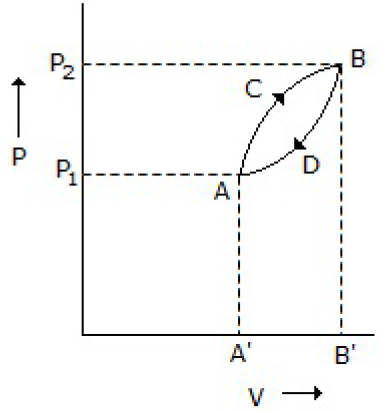1m3 of an ideal gas at 500 K and 1000 kPa expands reversibly to 5 times its initial volume in an insulated container. If the specific heat capacity (at constant pressure) of the gas is 21 J/mole . K, the final temperature will be
35 K
174 K
274 K
154 K
Correct Answer :
C. 274 K
Related Questions
Gibbs free energy of mixing at constant pressure and temperature is always
0
∞
+ ve
- ve
The change in Gibbs free energy for vaporisation of a pure substance is
Positive
Negative
Zero
May be positive or negative
Pick out the wrong statement.
Surface tension of a substance vanishes at critical point, as there is no distinction between liquid and vapour phases at its critical point
Entropy of a system decreases with the evolution of heat
Change of internal energy is negative for exothermic reactions
The eccentric factor for all materials is always more than one
The total change in the enthalpy of a system is independent of the
Number of intermediate chemical reactions involved
Pressure and temperature
State of combination and aggregation in the beginning and at the end of the reaction
None of these
The Joule-Thomson co-efficient is defined as (∂T/∂P)H. Its value at the inversion point is
∞
1
0
-ve
A gas performs the maximum work, when it expands
Non-uniformly
Adiabatically
Isobarically
Isothermally
In reactions involving solids and liquids (where change in volume is negligible), the heat of reaction at constant pressure as compared to that at constant volume is
More
Less
Same
Unpredictable; depends on the particular reaction
Thermal efficiency of a Carnot engine can approach 100%, only when the temperature of the
Cold reservoir approaches zero
Hot reservoir approaches infinity
Either (A) or (B)
Neither (A) nor (B)
Pick out the wrong statement.
At constant pressure, solubility of a gas in a liquid diminishes with rise in temperature
Normally, the gases which are easily liquefied are more soluble in common solvents
The gases which are capable of forming ions in aqueous solution are much more soluble in water than in other solvents
At constant pressure, solubility of a gas in a liquid increases with rise in temperature
Two substances are in equilibrium in a reversible chemical reaction. If the concentration of each substance is doubled, then the value of the equilibrium constant will be
Same
Doubled
Halved
One fourth of its original value
Generation of heat by friction is an example of a/an __________ change.
Isothermal
Irreversible
Adiabatic
Reversible
When a gas is expanded from high pressure region to low pressure region; temperature change occurs. This phenomenon is related to the
Gibbs-Duhem equation
Gibbs-Helmholtz equation
Third law of thermodynamics
Joule-Thomson effect
Chemical potential of ith component of a system is given by
μi = (∂F/∂ni)T, P, ni
μi = (∂A/∂ni)T, P, ni
μi = (∂F/∂ni)T, P
μi = (∂A/∂ni)T, P
Cp of a gas at its critical temperature and pressure
Becomes zero
Becomes infinity
Equals 1 kcal/kmol °K
Equals 0.24 kcal/kmol °K
Isentropic process means a constant __________ process.
Enthalpy
Pressure
Entropy
None of these
For a constant pressure reversible process, the enthalpy change (ΔH) of the system is
Cv.dT
Cp.dT
∫ Cp.dT
∫ Cv.dT
Air enters an adiabatic compressor at 300K. The exit temperature for a compression ratio of 3, assuming air to be an ideal gas (Y = Cp/Cv = 7/5) and the process to be reversible, is
300 × (32/7)
300 × (33/5)
300 × (333/7)
300 × (35/7)
The equation relating E, P, V and T which is true for all substances under all conditions is given by (∂E/∂V)T = T(∂P/∂T)H - P. This equation is called the
Maxwell's equation
Thermodynamic equation of state
Equation of state
Redlich-Kwong equation of state
What is the number of degree of freedom for a system of two miscible non-reacting species in vapor-liquid equilibrium forming an azeotrope?
0
2
1
3
In the reaction, represented by, 2SO2 + O2 2SO3; ΔH = - 42 kcal; the forward reaction will be favoured by
Low temperature
High pressure
Both (A) and (B)
Neither (A) nor (B)
Third law of thermodynamics is concerned with the
Value of absolute entropy
Energy transfer
Direction of energy transfer
None of these
Number of degrees of freedom for a three phase system in equilibrium comprising of three nonreacting chemical species is
2
0
1
3
Heat pump
Accomplishes only space heating in winter
Accomplishes only space cooling in summer
Accomplishes both (A) and (B)
Works on Carnot cycle
Vapour which is at a pressure smaller than the saturation pressure for the temperature involved is called a __________ vapour.
Superheated
Desuperheated
Non-condensable
None of these
Cv for an ideal gas
Does not depend upon temperature
Is independent of pressure only
Is independent of volume only
Is independent of both pressure and volume
Mollier diagram is a plot of
Temperature vs. enthalpy
Temperature vs. enthalpy
Entropy vs. enthalpy
Temperature vs. internal energy
Which is a state function?
Specific volume
Work
Pressure
Temperature
A thermodynamic system is taken from state A to B along ACB and is brought back to A along BDA as shown below in the P-V diagram. The net work done during the complete cycle is given by the area covered by

P1ACBP2P1
ACBB1A1A
ACBDA
ADBB1A1A
The efficiency of a Carnot heat engine operating between absolute temperatures T1 and T2 (when, T1 > T2) is given by (T1 - T2)/T1. The co-efficient of performance (C.O.P.) of a Carnot heat pump operating between T1 and T2 is given by
T1/(T1-T2)
T2/(T1-T2)
T1/T2
T2/R1
Critical temperature is defined as the temperature above which a gas will
Not liquify (barring exceptions)
Immediately liquify
Never liquify however high the pressure may be
None of these
